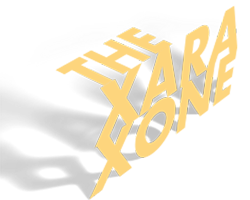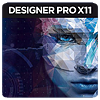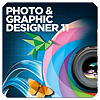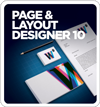
A tutorial by created by Paul Saumure (Psaumure online);
divulged to Gary Bouton (Gare online).
Creating a Battery With Extrudes
Download Resource File
Battery not included, some assembly required.
You can achieve much more than average results with the Extrude tool if you keep at least two things in mind while you create:
-
Your finished artwork might consist of many more than one extruded shape. The world’s a visually complex place, and reproducing the geometry you see in the real world frequently demands several pieces of grouped shapes.
-
The side of an extruded shape is just as visually interesting as the front, sometimes more so. This entire tutorial is based on the reality that when you extrude a circle and view it from the side, the result is a cylinder.
Not coincidentally, an AA battery is also cylindrical in shape. Now stop, hit Pause, do not Pass Go: before you begin creating a circle and extruding it, there’s a number of technical issues that need to be addressed, not in the least perspective: where is the object in relation to the camera, and what effect does the lens of the hypothetical camera do to distort the view on the battery?
Viewing A Battery’s Perspective: Front and Back Planes
In Figure 1, you can see an illustration very close to a photograph, and two dashed oval overlays which represent the front and back planes of this shape. On the bottom, the image looks fine and natural, and most of this is because our eyes are used to viewing images of objects that have a slight perspective toward the camera. At top, it’s clear that although the back plane seems to be angled mostly toward the audience (the camera), the front edge is described by an oval, not a circle, and this is because if you draw an infinite straight line at the top of the battery, and a second along the bottom line of the battery, the two lines will converge at a vanishing point, like railroad tracks do when viewed on the tracks themselves.

This phenomenon gives us a creative clue that the round shapes you’re going to extrude for the battery, the top copper part and the rest of the pieces needs to be oval, not perfectly circular.
Getting Down to Business
Just about all the cursory examinations are done, and there will be a reflective morsel or two along the way, but there’s no reason right now not to get started building the various pieces that make up the battery. Along the way, you’ll also discover some invaluable tips to working with the Extrude tool you can apply to your own projects. Trom this month’s resource file, open Coppertop cheat sheet.xar, and then zoom in on the group of shapes at bottom. As you can see in Figure 2, each shape corresponds to an element in the extrude composition at top. This is not a stroll in the park to reproduce, but it doesn’t require brain surgery, either. It requires a little patience and guidance, and yes, brain surgery probably requires patience, but that’s a tutorial for a different month.

Let’s begin at the back of the battery, with the long black piece:
-
With the Selector tool, select the back, black circle and then press
Ctrl+C. Alternately, if you want to build the battery from scratch, the circle color is black (#000000), and its 1.8” in diameter. -
Paste the circle and move it to a new, uncluttered area of the document. You can always drag the bottom edge of the page down to make some more room.
-
Choose the 3D tool from the Effects group on the Toolbar. With the circle selected with this tool, click the 3D icon, the Apply Extrusion command, at the far left of the Infobar. This button can also toggle an extruded shape on and off; be prepared for a TIP on this later.
-
The black circle is now in a default amount of extrude, with other default values applied. Instead of the imprecise, interactive way of setting angle and Depth, instead go to the Infobar and with Extrude Depth chosen as the Extrusion Parameter from the drop-down list, type 259 in the value field and then press Enter to apply the change. In the bevel type fields to the right of the extrude values, set the bevel type to Rounded, and the value to 1, just so the edge has a highlight or two across it. Figure 3 shows the process in progress. Or the progress in process.

-
Posing the cylinder is next to impossible manually. Let’s just accept Angle 1 should be -3 and Angle 2 is 46. Choose the type, and then type in these vales, followed by a hit on Enter.
-
Save your document; keep it open as you move on.
Lighting the Battery
By default the black shaft of the battery is Shiny, and this is an opportunity to light the battery, and keep all the rest of the pieces harmonious by copying this first lighting scheme.
-
With the Extrude tool selected and the 3D icon on the Infobar in its on (depressed) state, click the light bulb button on the Infobar (see Figure 4). It just so happens in this example that Light 3 has a blue color and this is ideal to “paint” a blue streak horizontally across the black cylinder. A white highlight would communicate “plastic” to the viewer”, but a blue highlight is a classic “metal” reflection.

-
Drag Light 3 around until the black cylinder has a blue highlight as seen in Figure 4.
-
If you don’t feel the highlight is bright enough, add illumination from Light 1. Hey, the cylinder is black—you’re not going to mess up the color of the cylinder by lighting it differently!
-
Save the document.
Moving to the Silver Band
One recent addition to the “coppertop” Double-A cell has been a collar, a band of silver across the mid-section of the battery. To reproduce this, you need a very slender black band to go to the far left of the composition, and a medium grey colored oval that has a strong highlight to suggest metal. Take a deep breath and plunge in!
-
To get precisely the same degree of rotation as the black cylinder, the easiest way to make the silver part is to copy the black cylinder and then paste its attributes onto the new shape. Naturally, the cylinder will be too long and the wrong color, but that’s simple to correct. With the cylinder selected and the Extrude tool active; select the cylinder and then press
Ctrl+C. -
Choose the grey circle and then press
Ctrl+Alt+Vto paste the Clipboard’s contents as attributes only. -
Choose the front part of the cylinder and then type the color (Hex #) b2b2b2 in the Color Editor’s Hex value box. Press Enter to apply the color value.
-
Feel free to squish the cylinder by dragging on its side, but to be precise and follow this (successful!) tutorial, apply an Extrude Depth of 21 to the guy, and a Round Face of 17 units.
-
Check out Figure 5 to see what the result of the past steps is, and with the Selector tool, move the silver cylinder wedge to the left of the black cylinder.

The Black Band
Sorry if this is anti-climactic (!), but creating the black band to the left of the silver band requires no more than the steps you just ran through to make the silver band. It’s actually less demanding, because the black cylinder from which you base the new extruded shape is already black. C’mon:
-
Select the black circle using the Extrude tool. Click the 3D button on the Infobar to begin a (default) extrude.
-
Perform the
Ctrl+C,Ctrl+Alt+Astep you used before to apply the same extrude values and shape color as you did early with the silver extrude. -
Set the Extrude Depth to 2 on the Infobar, and then set the Bevel type to Rounded with a value of 17, as shown in Figure 6.

-
With the Selector tool, position this piece directly to the left of the silver extruded shape.
-
Ctrl+S.
Coppertopping the Battery
There are no surprises in this section of building the battery; much like previous steps, you’re encouraged to sample an existing, finished extruded shape and then paste its attributes to the new shape, and then work backwards and correct the color, depth, and other parameters. Like this:
-
Make a copy of the orange shape by right-dragging on the shape with the Selector tool; releasing the right mouse button drops a copy of the selection. Now you have a shape from which to sample the original copper color.
-
Ctrl+Cany of the existing extruded shapes, and thenCtrl+Alt+Ato apply the attributes to the copper shape. -
With the new extrude selected, use the Color Editor (
Ctrl+E) to sample the copper color in the duplicate circle. -
Type 98 in the Extrude Depth num field, and then type 17 in the Bevel type with the Round Face preset chosen.
-
Optionally, you might want to display lights, choose Light 3 from the Color Editor (it’s way on top of the list) and make the blue cast more neutral, to keep the copper color a shiny copper color. See Figure 7.

-
With the Selector tool, move the copper extrude to the left of the existing shapes. For the sake of precision, you might want to press
Ctrl+Oto get to Options and then under General, you can set the Nudge size to 1 pixel. Now you can use the arrow keys on your keyboard to precisely land the copper piece onto the left of the rest of the shapes, as shown in Figure 8.
Making the Top and Contact Point
You’re in the home stretch now; only two more extrudes to make. The interesting thing about the top battery piece is that its fill is Conical with two additional color stops created. This oval serves you well as a visual replacement for the top of the battery: no one can tell whether it has depth (an extrude) because it’s nestled between the contact shapes and the top of the copper piece.
-
All you do is take the Selector tool and move the oval to the far left of the composition, covering the top of the copper shape. Here’s an opportunity to use the keyboard nudge keys. Figure 9 shows the placement and what the top will look like once you fashion the contact shapes.

-
Select the far left small oval. It is interesting to note that this piece does not have a simple Linear gradient fill, but a four color linear fill instead. Get out the Fill tool and check it out. By using multiple color points, the transition between light and dark is a gradual one, not easily replicated with a two-point fill.
-
After you have an extrusion at the correct viewing angle, apply an Extrude Depth of 30, and try a new Bevel type, Rolled, which adds a nice visual complexity to the nub/contact point. Use an amount of 230 to really make this piece rounded off. See Figure 10.

-
Right-click on the extruded piece, and then in the Color Editor make the Line Color #d3d3df. It might not be a well-known fact that extruded shapes can have their sides colored a different color than their face by choosing to recolor the outline of the shape, which makes little sense but provides a wonderful facility to visually complicate an extrude.
-
As you can see in Figure 10, the larger piece to the right of the nub shape gets an outline color of #505058, a Bevel type of Curved, amount 62, and an Extrude Depth of 30. Use the nudge keyboard feature or manually use the Selector tool to move these last two pieces into place.
-
Group the shapes (
Ctrl+G) and save your work.
Non-Extrude Fun Embellishment
The font used for the name of the battery you see in the stores is Delta Jaeger, just as an informational point. You don’t have to buy the typeface; the text you need has been set for you and converted to curves. It is included in Coppertop cheat sheet.xar.
Now, the battery shows a cylindrical curve, so the text needs to show the same sort of distortion if it’s supposed to be on the battery and not floating above it. This is a job for the Mould tool:
-
Copy or move the gradient text to a position over the black part of the battery. Notice there’s a little shading to suggest lighting falloff on the surface of the battery. Try this technique out on text you apply to your own shapes.
-
Choose the Mould tool from the effects tools flyout on the Toolbar.
-
Click the Concave Envelope button. Now, this is going to wildly distort the lettering, but the base of the distortion is sound and just needs a little refining. The most important part is that the top and bottom bounding lines are flat and not curved, exactly the shape of the top and bottom of the underlying battery.
-
With the Shape tool, drag the left curve to almost the junction of the top and bottom lines. Then do the same to the right wildly distorted curve. Stuff should fall into place, as shown in Figure 11.

-
Move the plus symbol into place and use the same techniques as demonstrated in steps 3 and 4. See Figure 12 for the complete deal in this section.

Making a Scene!
Okay, it doesn’t take that much more resources or grey matter to make this handsome drawing of a battery into a scene, the battery in context of resting on a shiny surface. Although the resources aren’t in the cheat sheet file, they are easy enough to create, trust in it:
-
Group all the battery shapes.
-
Create a rectangle with a linear gradient going from 60 to 70% grey at bottom to 10% grey at top. Duplicate and flip the copy vertically so there is a suggestion that light falls off at the edges of this background and a spotlight is hitting the center.
-
Group the two pieces and then put them behind the battery.
-
With the text grouped to the battery, duplicate anf flip the copy vertically. The easy way to do this is to hold onto the top selection handle, hold
CTRLand then drag down until you’ve flipped the copy180 degreesvertically, and then release the right mouse button to drop the flipped copy. -
The battery will not perfectly align to the bottom of the original because there is a slight perspective angle on the original; it can’t be helped without giving up a little of the visual interest of the battery’s pose. This is okay: with the duplicate upside-down battery selected, click on it to reveal the rotate and skew handles. Skew the battery upwards and then to the right to correct a little unwanted distortion, as shown in Figure 13.
-
Press
Ctrl+Shift+Cto make a bitmap copy of the duplicate. Choose to make the copy with an Alpha Channel, and then clickCreate. The upside-down duplicate extrude has served its purpose and can be deleted now. You need a bitmap copy to use the Camera effects. -
Select the bitmap copy and place it beneath the original in the picture. To suggest, say, a brushed chrome background upon which the battery rests, the reflection will be faint and blurred. Choose the Photo tool and then on the Infobar, drag the Set photo sharp or blurriness slider to around-66, as shown in Figure 14.

-
Choose the Transparency tool and drag from bottom to top across the face of the selected blurry battery, to suggest reflection falloff. Play with the transparency handles and even drag them outside of the battery shape to get a very subtle look, not to steal from the hero of the scene, your own Coppertop battery. See Figure 15.

Draw three more of the Coppertop batteries, and you’re all set to run a child’s toy for approximately ½ hour. That’s the thing about drawing portable power source in Xara: they hold a charge indefinitely. Have fun with all the new techniques you’ve learned and let’s talk about the project on TalkGraphics!
To show us how your artwork “keeps on going” with extrudes or to discuss this tutorial go to the thread for this tutorial in the Xara Xone forum on TalkGrapics.com.
(Psaumure online), is a retired computer consultant. A self-taught Xarist and has been using the program for five years. Among others, he credits Gary Priester and "Mohamed Elhlaly" Black Panther for being instrumental in his bootstrapping into Xara. Paul works the tutorials and you can see that he is a quick study, cranking out virtual masterpieces within a couple of hours. Photorealism is the modality of art within which Paul immerses himself, with occasional excursions into other motifs such as logos and 3D designs. You can get a healthy helping of Paul's other magnificent works at his recently revamped and visually sumptuous website,The Computer Wave online.
The tutorial Creating a Battery With Extrudes including the artwork and the downloadable examples file are Copyright © 2015 Paul Saumure. All Rights Reserved.











